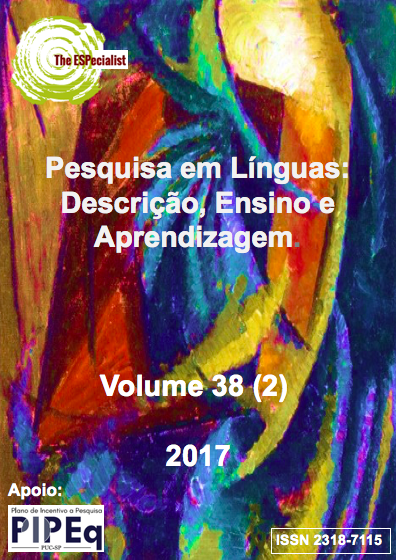O PAPEL DOS MARCADORES DISCURSIVOS NA ESCRITA E NA FALA: UMA TAXONOMIA TEXTUAL E INTERPESSOAL SOB O ENFOQUE DA LINGUÍSTICA SISTÊMICO-FUNCIONAL
DOI:
https://doi.org/10.23925/2318-7115.2017v38i2a4Palavras-chave:
Marcadores discursivos, Artigo de opinião, Conversa, Linguística Sistêmico-FuncionalResumo
Desconhecer que as escolhas lexicogramaticais da escrita diferem daquelas do oral, faz com que o falante realize uma transferência de características da oralidade para escrita, como o uso de marcadores discursivos. Este artigo examina a ocorrência dos marcadores discursivos textual e interpessoal e sua função na persuasão do texto. O corpus compõe-se de uma entrevista (Projeto NURC) e de um artigo de opinião (Folha de S. Paulo). A Pesquisa tem apoio da Linguística Sistêmico-Funcional, desta forma a entrevista e o artigo de opinião foram segmentados em unidades oracionais, cujas relações discursivas foram analisadas a partir das subcategorias dos MDs Textual e Interpessoal. Nas duas modalidades a preponderância quanto ao uso dos marcadores ficou para os Textuais, embora na oralidade sua presença tenha sido maior. Por outro lado, a presença de Interpessoais foi maior na escrita.
Referências
CASTILHO, A.T.; PRETI, D. (orgs.) 1986. A linguagem falada culta na cidade de São Paulo. 1 – Elocuções Formais. São Paulo: T.A.Queiroz Editor.
DAFOUZ-MILNE, E. 2008. The pragmatic role of textual and interpersonal metadiscourse markers in the construction and attainment of persuasion: a cross-linguistic study of newspaper discourse. Journal of Pragmatics, 40, p. 95-113.
DAFOUZ, E. 2003. Metadiscourse revisited: a contrastive study of persuasive writing in professional discourse. Estudios Ingleses de la Universidad Complutense, 11, p. 29-52.
EGGINS, S. 1994. An introduction to systemic functional linguistics. London: Pinter.
FRASER, B. 1999. What are discourse markers? Journal of Pragmatics, 31, p. 931-952.
HALLIDAY, M.A.K. 1994. An introduction to functional grammar. 2. ed. London: Edward Arnold.
HEMPEL, S. e DEGAND, L. 2008. Sequencers in different text genres: academic writing, journalses and fiction. Journal of Pragmatics, 40, p. 676-693.
HYLAND, K. 2005. Metadiscourse, exploring interaction in writing. Oxford: Continuum.
___________. 1998a.Persuasion and context: the pragmatics of academic discourse. Journal of Pragmatics, 30, p. 437-455.
HYLAND, K., TSE, P. 2004. Metadiscourse in academic writing: a reappraisal. Applied Linguistics, 25, p. 156-177.
LEE, S.H. 2008. An integrative framework for the analyses of argumentative- persuasive essays from an interpersonal perspective. Text & Talk, 28, p. 270-339.
MAO, L.R. 1993. I conclude not: toward a pragmatic account of metadiscourse. Rhetoric Review , 11, p. 265-89.
MAURANEN, A. 1993. Cultural differences in academic rhetoric. Frankfurt: Peter Lang.
REDEKER, G. 1990. Ideational and pragmatic markers of discourse structure. Journal of Pragmatics, 14, p. 367-381.
RISSO, M.S. 1999. Aspectos textuais-interativos dos marcadores discursivos de abertura bom, bem, olha, ah, no português culto falado. In: M.H. MOURA NEVES (Org.) Gramática do Português Falado – VII: Novos Estudos. SP: FAPESP; UNICAMP.
_________. 1996. O articulador discursivo ‘então’. In: CASTILHO, A.T.; BASÍLIO, M. (Org.) Gramática do Portruguês – IV: Estruturas Descritivas. SP: FAPESP; UNICAMP.
RISSO, M.S., URBANO, H. 1992. Marcadores conversacionais: uma busca de traços padrões. Projeto de pesquisa apresentado no VI Seminário do Projeto de Gramática do Português Falado. Campos do Jordão.
ROSSI, C. 2009. Templo é dinheiro? Folha de São Paulo, São Paulo, 28 ago. Primeiro Caderno, p. 2.
SCHIFFRIN, D. 2001. Discourse markers: language, meaning and context. In: D. SCHIFFRIN, D. TANNEN, H.E. HAMILTON (Org.). The Handbook of Discourse Analysis. Malden: Blackwell.
__________. 1987. Discourse Markers. Cambridge: Cambridge University Press.
SPERBER, D. WILSON, D. 1995. Relevance: communication and cognition. 2. ed. Oxford: Blackwell.
TABOADA, M. 2006. Discourse markers as signals (or not) of rhetorical relations. Journal of Pragmatics, 38, p. 567-592.
THOMPSON, G. 2001. Interaction in academic writing: learning to argue with the reader. Applied Linguistics, 22, p. 58-78.
THOMPSON, G. & THETELA, P. 1995. The sound of one hand clapping: The management of interaction in written discourse. Text, 15, p. 103-127.
Downloads
Publicado
Como Citar
Edição
Seção
Licença
Os autores concedem à revista todos os direitos autorais referentes aos trabalhos publicados. Os conceitos emitidos em artigos assinados são de absoluta e exclusiva responsabilidade de seus autores.


 Esta obra está licenciada com uma Licença
Esta obra está licenciada com uma Licença 

